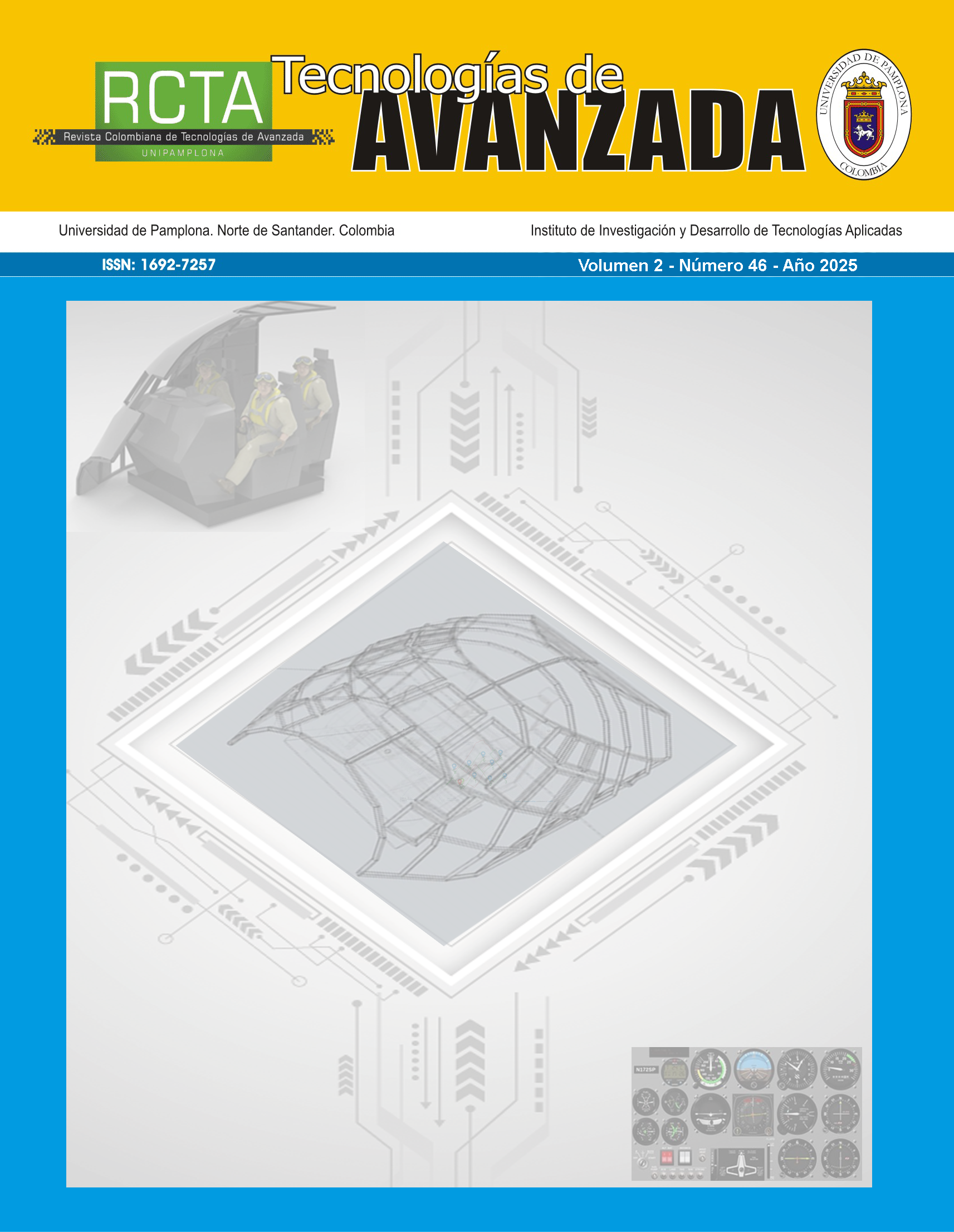Control industrial por aprendizaje reforzado
DOI:
https://doi.org/10.24054/rcta.v2i46.4141Palabras clave:
aprendizaje reforzado, eficiencia, inteligencia artificial, proceso industrialResumen
En este artículo se presenta la implementación de la técnica de control de caudal con inteligencia artificial (DDPG) en un prototipo funcional completamente instrumentado con sensores y actuadores industriales, simulando la recirculación de caudal a través de tres tanques. Se presenta la metodología utilizada para la identificación del proceso (modelo de primer orden más tiempo muerto (FOPDT)) mediante comunicación OPC Cliente Servidor con Matlab®. También se presenta el diseño del algoritmo de aprendizaje por refuerzo y su adaptación en el entorno de aprendizaje con datos experimentales. Los resultados de la simulación fueron satisfactorios en comparación con las técnicas de control tradicionales, demostrando robustez frente a perturbaciones forzadas. Finalmente, se evaluó la implementación del control de aprendizaje reforzado integrando TIA Portal y Matlab (a través de un controlador PLC-S7-1500) con una referencia de 600 l/h, logrando un sobre impulso del 0% con un tiempo de asentamiento de 22s. Comparado con otros sistemas de control, se observó una mejor respuesta en el tiempo de asentamiento y un control libre de sobre impulso. Finalmente, se aplicaron perturbaciones al sistema, observando su efecto con relación al flujo.
Descargas
Citas
Kaelbling, Leslie Pack; Littman, Michael L.; MOORE, Andrew W. Reinforcement learning: A survey. Journal of artificial intelligence research, 1996, vol. 4, p. 237-285
Carlos G´omez, J., Verrastro, C. A.. Aprendizaje por refuerzo y control difuso para generar comportamiento de robots. Edu.ar. from 2022, de https: //www.f rba.utn.edu.ar/wp content/uploads/2021/02/jar8submission30.pdf
Wang, Zhe; Hong, Tianzhen. Reinforcement learning for buildingcontrols: The opportunities and challenges. Applied Energy, 2020, vol.269, p. 115036.
Damjanovi ´C, Ivana, et al. High Performance Computing Reinforcement Learning Framework for Power System Control. En 2023 IEEEPower Energy Society Innovative Smart Grid Technologies Conference (ISGT). IEEE, 2023. p. 1-5.
V. Abad-Alcaraz, M. Castilla, J.D. Álvarez (2024) A Comparison of Classical and Reinforcement Learning-based Tuning Techniques for PI controllers, IFAC-papers OnLine Volume 58, Issue 7, 2024, Pages 180-185. doi: 10.1016/j.ifacol.2024.08.031.
Gunther, J., Reichensd¨orfer, E., Pilarski, P.M., and Diepold, K. (2020). Interpretable PID parameter tuning for control engineering using general dynamic neural networks: An extensive comparison. Plos One, 15(12), e0243320.
Ali, M., Firdaus, A.A., Arof, H., Nurohmah, H., Suyono, H., Putra, D.F.U., and Muslim, M.A. (2021). The comparison of dual axis photovoltaic tracking system using artificial intelligence techniques. IAES Int. J. Artif. Intell, 10(4), 901.
Daye Yang, Jingcheng Wang, Huihuang Cai, Jun Rao, Chengtian Cui, (2025) Intelligent control strategy for electrified pressure-swing distillation processes using artificial neural networks-based composition controllers, Separation and Purification Technology, Volume 360, Part 2, 2025, 130991, ISSN 1383-5866.
Ibtihaj Khurram Faridi, Evangelos Tsotsas, Wolfram Heineken, Marcus Koegler, Abdolreza Kharaghani, Development of a neural network model predictive controller for the fluidized bed biomass gasification process, Chemical Engineering Science, Volume 293, 2024, 120000, ISSN 0009-2509.
Hong-Gui Han, Lu Zhang, Hong-Xu Liu, Jun-Fei Qiao, Multiobjective design of fuzzy neural network controller for wastewater treatment process, Applied Soft Computing, Volume 67, 2018, Pages 467-478, ISSN 1568-4946.
P. Siva Krishna, P.V. Gopi Krishna Rao, Fractional-order PID controller for blood pressure regulation using genetic algorithm, Biomedical Signal Processing and Control, Volume 88, Part B, 2024, 105564, ISSN 1746-8094.
Marco Paz Ramos, Axel Busboom, Andriy Slobodyan, Genetic PI Controller Tuning to Emulate a Pole Assignment Design This work was supported by the Bavarian Ministry of Economic Affairs, Regional Development and Energy (StMWi) under Grant DIK0397/03., IFAC-PapersOnLine, Volume 58, Issue 7, 2024, Pages 138-143, ISSN 2405-8963.
K.G Aparna, R. Swarnalatha, Dynamic optimization of a wastewater treatment process for sustainable operation using multi-objective genetic algorithm and non-dominated sorting cuckoo search algorithm, Journal of Water Process Engineering, Volume 53, 2023, 103775, ISSN 2214-7144
Himanshukumar R. Patel, Optimal intelligent fuzzy TID controller for an uncertain level process with actuator and system faults: Population-based metaheuristic approach, Franklin Open, Volume 4, 2023, 100038, ISSN 2773-1863.
Slavica Prvulovic, Predrag Mosorinski, Dragica Radosav, Jasna Tolmac, Milica Josimovic, Vladimir Sinik, Determination of the temperature in the cutting zone while processing machine plastic using fuzzy-logic controller (FLC), Ain Shams Engineering Journal, Volume 13, Issue 3,2022, 101624, ISSN 2090-4479.
Rios H. R, Apráez B. A., Rodriguez C. J and Tumialan. B. J. A., PI tuning based on Bacterial Foraging Algorithm for flow control, (2020) IX International Congress of Mechatronics Engineering and Automation (CIIMA), Cartagena, Colombia, 2020, pp. 1-6, doi: 10.1109/CIIMA50553.2020.9290289.
Ali, M., Firdaus, A.A., Arof, H., Nurohmah, H., Suyono, H., Putra, D.F.U., and Muslim, M.A. (2021). The comparison of dual axis photovoltaic tracking system using artificial intelligence techniques. IAES Int. J. Artif. Intell, 10(4), 901.
Shuprajhaa, T., Sujit, S.K., and Srinivasan, K. (2022). Reinforcement learning based adaptive pid controller design for control of linear/nonlinear unstable processes. Applied Soft Computing, 128, 109450.
Lei, Y., Zhan, S., Ono, E., Peng, Y., Zhang, Z., Hasama, T., and Chong, A. (2022). A practical deep reinforcement learning framework for multivariate occupant centric control in buildings. Applied Energy, 324, 119742.
Yu, L., Xie, W., Xie, D., Zou, Y., Zhang, D., Sun, Z., Zhang, L., Zhang, Y., and Jiang, T. (2019). Deep reinforcement learning for smart home energy management. IEEE Internet of Things Journal, 7(4), 2751–2762.
Matetic, I., Stajduhar, I., Wolf, I., and Ljubic, S. (2023). Improving the efficiency of fan coil units in hotel buildings through deep-learning-based fault detection. Sensors, 23(15), 6717.
Andina de Integración Tecnológica (ANITCO), Manual de operación y mantenimiento unidad de entrenamiento en automatización, 1ra ed. Bogotá, Colombia: ANITCO, 2016.
Mathworks, Reinforcement Learning Toolbox™ User’s Guide, Matlab and Simulink, MathWorks, Natick, MA, USA, 2020. [En Línea] Disponible en: https://www.mathworks.com/help/reinforcement-learning/
Alfaro, Víctor M. Método de identificación de modelos de orden reducido de tres puntos 123c. Escuela de Ingeniería Eléctrica Universidad de Costa Rica, 2007, p. 1-7
Descargas
Publicado
Cómo citar
Número
Sección
Licencia
Derechos de autor 2025 Yessica Cindy Vannesa Mora Cubides, Daniel Steven Arias Otálora, José Antonio Tumialan Borja, Hugo Fernando Velasco Peña

Esta obra está bajo una licencia internacional Creative Commons Atribución-NoComercial 4.0.















